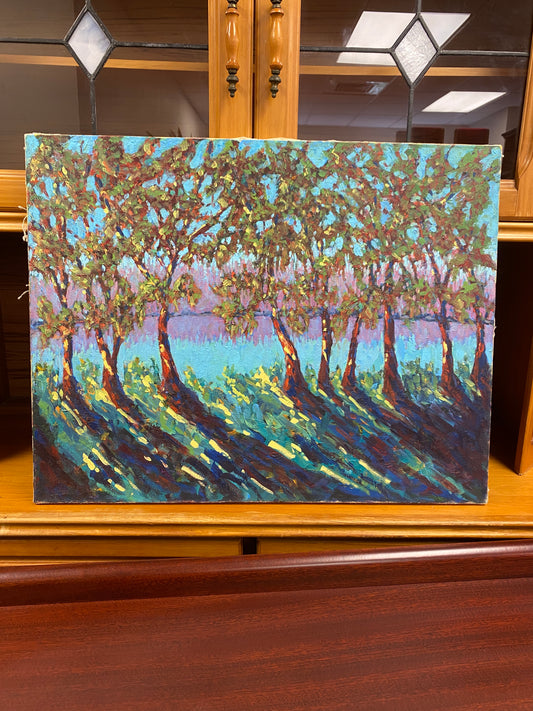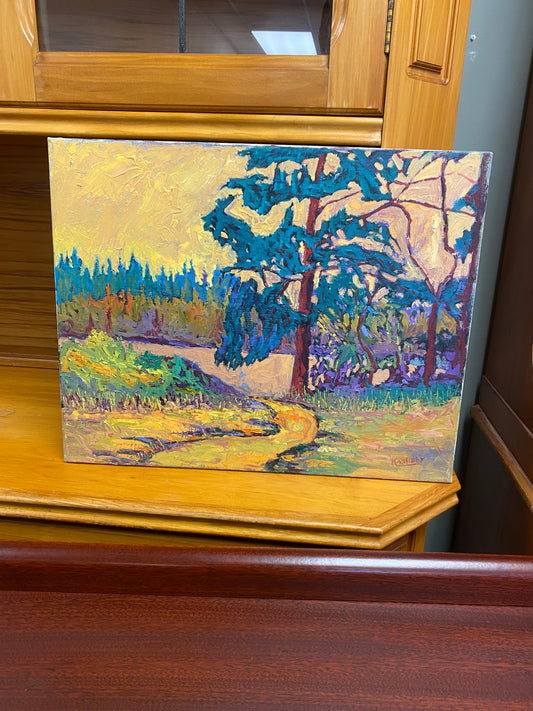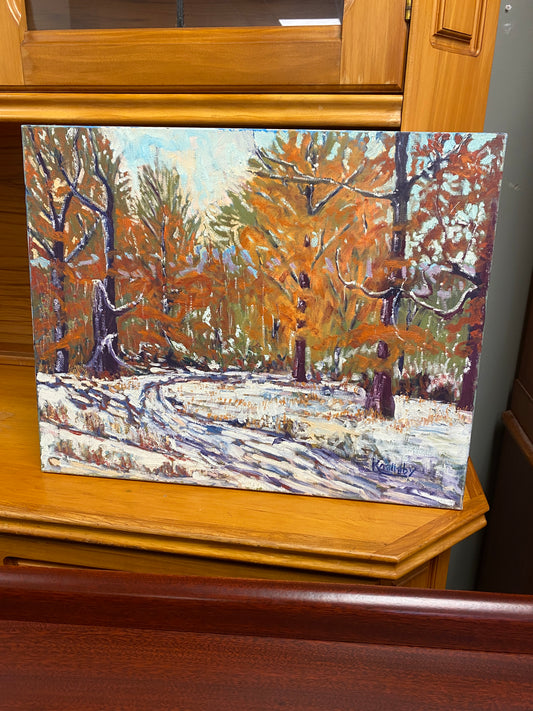Vintage Art and Paintings: Building an Authentic Collection That Tells Your Story
Walk into any home decorated with mass-produced prints from furniture stores, and you'll see the same generic landscapes, abstract shapes, and motivational quotes staring back from identical frames.
Now imagine walls filled with vintage art paintings – original works created by real artists decades ago, each piece carrying the patina of time, the confidence of authentic brushstrokes, and stories that no reproduction can replicate.
Collecting vintage art isn't about impressing others with expensive masterpieces. It's about surrounding yourself with genuine creativity, supporting the legacy of working artists, and building a personal collection that reflects your taste, values, and curiosity about the world.
Understanding Vintage Art: More Than Just Old Pictures
Vintage art encompasses original works created roughly between the 1920s and 1980s – pieces old enough to have developed character and historical context, but not so ancient that they're museum artifacts beyond most collectors' reach. This sweet spot offers incredible opportunities for discovering quality art at accessible prices.
What makes vintage art special:
- Original brushwork you can see and feel on the canvas
- Historical context that adds depth and meaning to pieces
- Unique perspectives from artists working in different eras and movements
- Investment potential as quality pieces often appreciate over time
- Authentic materials – real canvas, quality paints, solid frames
- Individual character that mass-produced art simply cannot replicate
Categories of vintage art paintings:
- Mid-century modern works from the 1940s-1960s
- Post-war abstract pieces exploring new artistic languages
- Regional landscapes showing places as they once were
- Portrait studies capturing people and fashions from past decades
- Still life paintings demonstrating classical techniques and subjects
- Folk art representing authentic cultural expressions
Why Vintage Art Paintings Beat Modern Reproductions
The Quality Difference
Original vintage art paintings were created by artists who understood materials, techniques, and composition. Even lesser-known artists from previous generations often had formal training and technical skills that show in their work.
Technical advantages of vintage art:
- Real canvas rather than paper or synthetic materials
- Quality pigments that have aged beautifully rather than faded
- Proper framing with materials designed to last decades
- Visible brushwork that adds texture and visual interest
- Layered composition built up over time rather than printed instantly
The Character Factor
Vintage art paintings carry the subtle signs of age that give them character – not damage, but the gentle patina that comes from being loved and lived with. A slight darkening of varnish, the settling of paint, the gentle aging of canvas – these qualities add warmth and authenticity that new works take decades to develop.
The Story Element
Every vintage art painting has a history. Who was the artist? When and why was it painted? Who owned it before you? These questions add layers of meaning that transform wall decoration into conversation pieces and family heirlooms.
Building Your Vintage Art Collection: Where to Start
Define Your Personal Aesthetic
Before you buy your first piece, spend time understanding what genuinely appeals to you. Vintage art collecting is most rewarding when it reflects your authentic taste rather than what you think you should like.
Questions to guide your collecting:
- What subjects draw your eye – landscapes, portraits, abstracts, still lifes?
- Do you prefer realistic or stylized approaches?
- What colors make you feel most at home?
- Are you drawn to bold statements or subtle beauty?
- Do you want pieces that match your décor or challenge it?
Understanding Eras and Movements
1920s-1940s: Early Modern Movements
This period includes Art Deco influences, early abstract experiments, and the transition from traditional to modern approaches. Look for geometric compositions, bold colors, and experimental techniques.
1940s-1960s: Mid-Century Confidence
Post-war optimism produced art with strong compositions, confident brushwork, and interesting color palettes. This era offers excellent value for collectors, as many quality pieces haven't yet reached their full market potential.
1960s-1980s: Diverse Expressions
From pop art influences to continued abstract exploration, this period offers incredible variety. You'll find everything from photorealistic studies to bold expressionist works.
Setting a Realistic Budget
Vintage art paintings can be found at every price point, from under $50 for small works by unknown artists to thousands for pieces by recognized names. The key is knowing where to spend and where to save.
Budget allocation strategy:
- Start small with pieces under $200 to develop your eye and preferences
- Invest selectively in one or two higher-quality pieces as anchor points
- Consider restoration costs when evaluating damaged but promising pieces
- Factor in framing if pieces need new frames or conservation work
Where to Find Quality Vintage Art Paintings
Estate Sales: The Collector's Goldmine
Estate sales, especially in older, affluent neighborhoods, often yield the best vintage art discoveries. Look for sales that mention "art collection" or "artist's estate" in their descriptions.
Estate sale strategies:
- Arrive early for the best selection, but return on the final day for better prices
- Look beyond the obvious – check bedrooms, hallways, and storage areas
- Ask about unlisted items – sometimes the best pieces aren't displayed
- Bring measurements and a flashlight for examining condition
Auction Houses: From Local to International
Local auction houses often have wonderful vintage art at reasonable prices, while regional auctions can offer pieces by artists with local significance.
Auction house advantages:
- Authenticated pieces with provenance information
- Detailed condition reports for informed bidding
- Preview opportunities to examine works closely
- Expert knowledge from auction house staff
Antique Stores and Vintage Shops
Established dealers often have curated selections and can provide valuable information about artists and periods.
What to look for in dealers:
- Specialisation in art or specific periods
- Knowledge about the pieces they sell
- Fair pricing relative to condition and significance
- Return policies for misattributed or damaged works
Online Marketplaces: Expanding Your Reach
Online platforms dramatically expand your access to vintage art, but require more careful evaluation of condition and authenticity.
Online buying tips:
- Request additional photos of signatures, condition issues, and frame details
- Research comparable sales to understand fair market values
- Understand return policies before bidding or buying
- Factor in shipping costs and insurance for valuable pieces
Evaluating Vintage Art Paintings: What to Look For
Assessing Artistic Quality
Not all vintage art is created equal. Learning to recognize quality helps you make better collecting decisions.
Quality indicators:
- Strong composition that leads the eye through the painting
- Confident brushwork showing technical skill and artistic vision
- Appropriate color relationships that create harmony or intentional contrast
- Finished quality indicating the artist considered the work complete
- Signature and dating showing the artist's pride in the work
Understanding Condition Issues
Vintage art paintings will show some age, but understanding the difference between acceptable aging and serious problems is crucial.
Acceptable aging:
- Gentle color shifts from natural aging of pigments
- Minor surface dust that can be professionally cleaned
- Slight canvas loosening that can be addressed by a conservator
- Vintage frame wear that adds character
Serious problems to avoid:
- Active flaking of paint layers
- Tears or holes in the canvas
- Water damage or staining
- Amateur restoration attempts that may have damaged the original
- Severe fading from improper light exposure
Researching Artists and Provenance
Part of vintage art collecting's appeal is discovering information about the artists and the paintings' histories.
Research resources:
- Artist signature databases for identifying unknown artists
- Auction record websites for understanding market values
- Local art societies for information about regional artists
- Museum collections that might include works by the same artist
- Gallery records from dealers who previously sold the artist's work
Caring for Your Vintage Art Collection
Proper Display Conditions
Vintage art paintings have survived decades, but proper care ensures they'll last for generations more.
Environmental considerations:
- Avoid direct sunlight which fades pigments over time
- Maintain stable humidity to prevent canvas expansion and contraction
- Ensure adequate air circulation to prevent mold and mildew
- Keep away from heat sources that can dry and crack paint layers
- Use UV-filtering glass in frames for additional protection
Professional Conservation vs. DIY Care
Understanding when to seek professional help and what you can safely do yourself protects your investment and preserves the art.
DIY maintenance:
- Gentle dusting with a soft, clean brush
- Monitoring for changes in condition
- Proper hanging with appropriate hardware
- Basic frame maintenance like tightening corners
Professional conservation needs:
- Cleaning beyond surface dust removal
- Structural repairs to canvas or frame
- Varnish removal or application
- Color restoration where original paint has been lost
Creating Cohesive Collections from Diverse Pieces
Finding Connections Between Different Works
Vintage art paintings don't need to match perfectly to work together beautifully. Successful collections often span different periods, styles, and artists while maintaining visual or thematic connections.
Strategies for cohesion:
- Color relationships – pieces that share similar palettes or complement each other
- Scale consistency – grouping works of similar or intentionally varied sizes
- Thematic connections – landscapes from different eras, portraits with similar moods
- Technical approaches – paintings that share brushwork styles or artistic philosophies
- Cultural or geographic links – works from the same region or movement
Displaying Collections Effectively
How you hang and group vintage art paintings dramatically affects their impact and your enjoyment of them.
Display principles:
- Create focal points with your strongest pieces
- Use proper lighting to show works at their best
- Consider viewing distances – larger works need more space
- Group thoughtfully rather than filling every available wall space
- Leave room for growth as your collection expands
The Investment Perspective: Building Value Over Time
Understanding Market Trends
While you should collect vintage art because you love it, understanding market dynamics helps you make smarter purchasing decisions.
Factors affecting value:
- Artist recognition and career development
- Rarity of available works
- Condition and provenance documentation
- Market trends in collecting preferences
- Cultural significance of particular movements or periods
Documentation and Provenance
Maintaining records about your vintage art paintings protects your investment and adds to their historical value.
Important records to keep:
- Purchase documentation with price and source information
- Artist research and biographical information
- Condition reports and any conservation work performed
- Photography documenting the work's current state
- Provenance information about previous owners when available
Living with Vintage Art: Beyond Decoration
Creating Personal Connections
The best vintage art collections aren't just decorative – they become part of your daily life, offering new discoveries and continuing enjoyment.
Ways to deepen your connection:
- Learn about the artists and their historical contexts
- Understand the techniques used in your pieces
- Share stories about your discoveries with friends and family
- Document your collection with photos and research notes
- Connect with other collectors who share your interests
The Emotional Value of Authentic Art
Living with original vintage art paintings changes how you experience your space. Instead of generic decoration, you're surrounded by genuine human creativity and expression.
Benefits of authentic art ownership:
- Daily inspiration from seeing real artistic skill and vision
- Conversation starters that engage guests and create connections
- Personal satisfaction from supporting artistic legacy
- Cultural preservation by maintaining and cherishing historical works
- Generational value creating heirlooms for future family members
Starting Your Vintage Art Journey
Your First Purchase Strategy
Begin your vintage art collecting journey with pieces that genuinely speak to you, regardless of artist recognition or investment potential. Your first purchases teach you about your preferences and help develop your collecting eye.
Beginner-friendly approaches:
- Start with smaller pieces to minimize financial risk while learning
- Choose subjects you love regardless of current market trends
- Buy from reputable sources to ensure authenticity and fair pricing
- Document everything to begin building your collection records
- Trust your instincts while gradually educating your eye
Building Knowledge and Confidence
Successful vintage art collecting develops over time as you learn to recognize quality, understand different artistic movements, and develop relationships with dealers and other collectors.
Continuing education strategies:
- Visit museums to see high-quality examples of different periods
- Read art history focused on eras that interest you
- Attend gallery openings and auction previews to see works in person
- Join collector groups online or in your community
- Take classes in art history or studio techniques
The Lasting Appeal of Vintage Art Paintings
Collecting vintage art paintings offers something rare in our mass-produced world – the opportunity to live with authentic human creativity. Every piece represents an artist's vision, skill, and historical moment, preserved on canvas for you to discover and enjoy.
Whether you're drawn to bold mid-century abstracts, delicate landscape studies, or powerful portraits from decades past, vintage art collecting allows you to build a personal museum that reflects your taste, supports artistic legacy, and creates daily beauty in your life.
Your collection starts with a single piece that captures your imagination and makes you want to look at it every day. From there, you'll develop an eye for quality, an understanding of different artistic movements, and the confidence to trust your instincts about what deserves a place on your walls.
The best part about collecting vintage art paintings isn't the potential investment value or the impression they make on others – it's the daily pleasure of living surrounded by authentic creativity, knowing that you're preserving and cherishing works that might otherwise be forgotten.
Ready to start your vintage art collection? Begin by visiting local estate sales, antique shops, or online marketplaces with an open mind and a small budget. Your perfect first piece is waiting to be discovered, and your walls are waiting to tell your story.
Vintage Art & Paintings
-
'Landscape' - Acrylic on Canvas by Unknown
Regular price $165.00 NZDRegular price$245.00 NZDSale price $165.00 NZDSale -
Untitled by Keith Mallaby
Regular price $85.00 NZDRegular price$145.00 NZDSale price $85.00 NZDSale -
Sooke Beach by Keith Mallaby
Regular price $70.00 NZDRegular price$125.00 NZDSale price $70.00 NZDSale -
First Snow by Keith Mallaby
Regular price $70.00 NZDRegular price$125.00 NZDSale price $70.00 NZDSale



